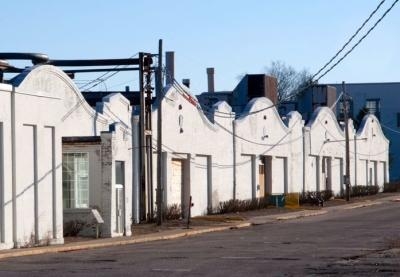Surrounding Buildings Torn Down To Reveal Historic Site
After nearly a century in obscurity, America’s first airplane factory began to reappear in 2013 as demolition crews peeled away surrounding buildings in Dayton, Ohio. The original Wright Company factory began to emerge on the 54-acre, former Delphi Home Avenue plant in west Dayton as demolition crews razed other buildings to prepare the site for redevelopment. The Wright Company factory was the first in the United States built for the purpose of producing airplanes.

Public and private partners have invested approximately $5 million in the Dayton Aviation Heritage Redevelopment Project. Their goal is to preserve the 20-acre historic parcel that includes the Wright Company factory and open the original two buildings to the public as a unit of the Dayton Aviation Heritage National Historical Park.
The project has made dramatic progress since December 2012, when Home Avenue Redevelopment LLC acquired the site from DPH Holdings Corp., the company that emerged from the Delphi Corporation bankruptcy proceedings. Most of the site has been cleared, and demolition is expected to wrap up early in 2014. Although still fenced off from the public, the Wright Company buildings can be glimpsed from Abby Avenue between West Third and U.S. 35, about two miles west of downtown Dayton.
Built in 1910 and 1911, the single-story, white-painted brick structures are distinguished by gracefully arched parapets on the fronts of the buildings. They are buildings 1 and 2 in a north-to-south row of five matching structures that include three later additions. A sixth building attached to the north side of Building 1 and a heating plant behind it are also to be demolished. “The Wright Company buildings are significant because they were the origins of the American aircraft industry. Every one of the major aerospace companies can trace its roots back to this site,” Dean Alexander, national park superintendent, said in May 2013.
Used for aircraft manufacturing through the First World War, the site offers a wide range of opportunities to examine the lives of American workers in the first decade of aircraft manufacturing, Alexander said. “This is a place where we can talk about World War I and middle-class manufacturing jobs. It’s a 100,000-square-foot blank canvas,” he said.
Besides preserving aviation history, Dayton city officials have said redevelopment of the property will be “transformative” for the neighborhood and surrounding areas by returning jobs to the site, removing more than 50 acres of vacant industrial properties and providing new public green space. In addition, a new national park unit will provide residents with a new source of neighborhood pride and vitality, while further strengthening the Dayton region’s essential role in aviation and commercial history, city officials said.
The National Aviation Heritage Alliance (NAHA) has worked for years with the city of Dayton, the National Park Service, Home Avenue Redevelopment and others to plan and guide the project. Wilbur and Orville Wright lived in Dayton and built their first flying machines in their west Dayton bicycle shop. They formed the Wright Company in New York in 1909. Wilbur died in 1912, and Orville sold his holdings in 1915. A new company, the Dayton-Wright Airplane Company, used the buildings to produce military aircraft parts in World War I. General Motors Corp. acquired Dayton-Wright and the factory buildings in 1919. It soon formed the Inland Manufacturing division there, converting the plant to auto parts production. The addition of three more buildings of similar style marked the beginning of decades of expansion. The original Wright Company buildings remained in active use as an Inland, Delco and Delphi plant until Delphi closed it in 2008.
In 2009, President Barack Obama signed an act that added the buildings to the boundaries of the Dayton Aviation Heritage National Historical Park along with Hawthorn Hill, Orville Wright’s Oakwood mansion.
Besides adding the two Wright Company buildings to the national park, the remaining three buildings offer opportunities for other institutions or companies to operate educational, research or commercial activities that complement the site’s aviation heritage, said Tony Sculimbrene, NAHA’s executive director. “Imagine learning how to design, build and maintain manned aircraft or UAVs (unmanned air vehicles) in the very place where the industry began,” he said.
The remaining 34 acres will be available for new commercial construction, presenting an opportunity for aerospace companies to locate operations at the birthplace of America’s aerospace industry, Sculimbrene said.
(Image provided by NAHA)
 Airborne 07.11.25: New FAA Boss, New NASA Boss (Kinda), WB57s Over TX
Airborne 07.11.25: New FAA Boss, New NASA Boss (Kinda), WB57s Over TX Airborne-Flight Training 07.10.25: ATC School, Air Race Classic, Samson School
Airborne-Flight Training 07.10.25: ATC School, Air Race Classic, Samson School Airborne Affordable Flyers 07.03.25: Sonex HW, BlackShape Gabriel, PRA Fly-In 25
Airborne Affordable Flyers 07.03.25: Sonex HW, BlackShape Gabriel, PRA Fly-In 25 Airborne-Flight Training 07.10.25: ATC School, Air Race Classic, Samson School
Airborne-Flight Training 07.10.25: ATC School, Air Race Classic, Samson School Rick Kenin New Board Chair of VAI
Rick Kenin New Board Chair of VAI



